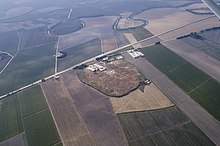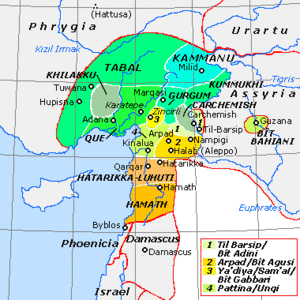Tell Tayinat
 Tell Tayinat | |
 Shown within Turkey | |
| Location | Hatay Province, Turkey |
|---|---|
| Region | Levant |
| Coordinates | 36°14′51″N 36°22′35″E / 36.24750°N 36.37639°ECoordinates: 36°14′51″N 36°22′35″E / 36.24750°N 36.37639°E |
| Type | Settlement |
| Site notes | |
| Condition | In ruins |



Tell Ta'yinat is a low-lying ancient tell on the east bank at the bend of the ancient Orontes river where it flows throught the Amuq valley, in the Hatay province of southeastern Turkey about 25 kilometers south east of Antakya (ancient Antioch). It lies near Tell Atchana, the site of the ancient city of Alalakh and has been proposed as the site of Kinalua, the capital city of an Iron Age Neo-Hittite kingdom.
Identification[]
Archaeologist Timothy Harrison, the dig director for many years starting in 2004, supports the identification of the site with Kinalua, the capital of a Neo-Hittite/Aramean Iron Age kingdom.[1]
It is a possible site of the city of Calneh mentioned in the Hebrew Scriptures.[2]
History and archaeology[]
Archaeological excavation at the tell has indicated, in conjunction with ancient written sources, that the site was a major urban centre in two separate phases, during the Early Bronze Age and Early Iron Age.[3]
History of excavation and research[]
Archaeological excavations were conducted at the site by the University of Chicago's Oriental Institute from 1935 to 1938, led by Robert Braidwood.[4][5] In 1999, the Oriental Institute returned to the site to conduct a survey and to examine the original excavations.[6]
New excavations at the site were begun by a team from the University of Toronto in 2004, after a survey in 2003.[7] Timothy Harrison, [8] Continued excavations in the summer of 2005 exposed more of the Iron Age temple as well as part of one of the early Iron Age II bit-hilanis. A significant amount of earlier Iron Age I material was also uncovered as well as small amounts of Early Bronze Age material.[9] Excavations have continued now for a total of 13 seasons, through 2016.[10][11][12] [13] [14] [15] [16] [17] [18] [19] [20] [21] Findings have included a significant Iron Age temple, a number of 1st millennium BC cuneiform tablets, and initial structures from the earlier Bronze Age settlement.[22]
A lecture by James Osborne, on "The Syro-Anatolian City States: A Neglected Iron Age Culture" addresses aspects of the site.[23]
Early Bronze Age[]
In the Amuq Plain, Tell Tayinat was the largest settlement in the EBII-EBIIIA.[24]
The red-black burnished ware (Karaz ware) is recovered in large quantities from the Early Bronze Age (EBA) II and IIIa levels. It is among the most commonly used pottery on the site.[25] This type of pottery diminishes through the end of the last phase of EBA.[26] This pottery is believed to be influenced by the Kura-Araxes culture, arriving into this area around 3000 BCE.[27]
From the Early Bronze IVB (EBIVB) significant ceramic remains have been found.[24]
Iron Age[]
During the Iron Age II, this is thought likely to be the site of ancient Kinalua, the capital of one of the Neo-Hittite/Aramean city-kingdoms of Walistin (Aramaic) or Palistin (neo-Hittite), of which a follow-up kingdom is the one known as Pattin or Patina, the shortened form of Palistin (together c. 1000-738 BC).[28][29][30] Among the culturally diverse Syro-Hittite states in the north Syrian river-plain the rulers of Kinalua continued to bear royal Hittite names in the 8th century BCE. At the first Assyrian conquest in the 870s BCE, the victors carried away from Kinalua silver and gold, 100 talents of tin, essential for making bronze, and 100 talents of iron, 1000 oxen and 10,000 sheep, linen robes and decorated couches and beds of boxwood, as well as "10 female singers, the king's brother's daughter with a rich dowry, a large female monkey and ducks".[31] At a later campaign the Assyrians forced its king Tutammu to submit.[citation needed]
The city had a citadel placed at a higher elevation, connected to the lower city by a monumental gate complex.[29]
Iron Age temple[]
One of the key finds of the Oriental Institute (1935–38) made at the site was a temple reminiscent in plan to the descriptions of King Solomon's Temple in the Old Testament.[6][32]
Bit-hilani palaces[]
The Oriental Institute campaigns (1935–38) brought to light several large palaces in the style known as Bit-hilani.[6] The 2005 excavations exposed part of one of the early Iron Age II bit-hilanis.[9]
King Suppiluliuma statue[]
In August 2012, a team from the University of Toronto announced they had uncovered the head and torso of a human figure, intact to just above its waist. The remains of the figure stand approximately 1.5 meters in height, suggesting a total height of 3.5 to 4 meters. The figure is bearded with eyes made of black and white stone. The figure's hair has been styled in an elaborate series of curls arranged in rows. The arms of the figure extend forward from the elbow. Each arm has two arm bracelets adorned with lion heads. The figure’s left hand holds a shaft of wheat and its right hand holds a spear. The figure's chest is adorned with a crescent-shaped pectoral. A lengthy carved, raised relief inscription in Hieroglyphic Luwian runs across the figure's back. The inscription records the accomplishments and campaigns of King Suppiluliuma. He is likely the same king who as part of a Syrian-Hittite coalition in 858 BC fought against the Neo-Assyrian invasion of Shalmaneser III.
Female statue[]
In August of 2017, it was reported that a majestic female statue was discovered at the site, within the monumental gate complex leading to the upper citadel.[29] This may be an image of Kubaba, divine mother of the gods of ancient Anatolia. Or it may be Kupapiyas, who was the wife – or possibly mother – of Taita, the dynastic founder of ancient Tayinat. But it's also possible that the statue represents the wife of King Suppiluliuma. Archaeologist Timothy Harrison raised the possibility that women played quite a prominent role in the political and religious lives of these early Iron Age communities.[29]
See also[]
- Cities of the ancient Near East
- Short chronology timeline
- Euphrates Syrian Pillar Figurines
- Euphrates Handmade Syrian Horses and Riders
References[]
- ^ Lynn Welton et. al., Shifting Networks and Community Identity at Tell Tayinat in the Iron I (ca. 12th to Mid 10th Century B.C.E.), American Journal of Archaeology, vol. 123, no. 2, pp. 291-333, April 2019
- ^ Luukko, Mikko (2019). "Part 1: Aramaeans and Assyria". In Dušek, Jan; Mynářová, Jana (eds.). Gurraeans and Itu'aeans in the Service of the Assyrian Empire. Aramaean Borders: Defining Aramaean Territories in the 10th–8th Centuries B.C.E. Culture and History of the Ancient Near East. Leiden-Boston: BRILL. p. 110. ISBN 978-90-04-39853-5. Retrieved 8 January 2020.
- ^ [1]Stuart W. Manning et. al, Beyond megadrought and collapse in the Northern Levant: The chronology of Tell Tayinat and two historical inflection episodes, around 4.2ka BP, and following 3.2ka BP, PLOS ONE, October 29, 2020
- ^ [2] Robert J. Braidwood and Linda S. Braidwood, Excavations in the Plain of Antioch I: The Earlier Assemblages Phases A-J, Oriental Institute Publications 61, University of Chicago Press, 1960
- ^ [3] R. C. Haines, Excavations in the Plain of Antioch, Vol. II: The Structural Remains of the Later Phases: Chatal Hüyük, Tell Al-Judaidah, and Tell Tayinat, Oriental Institute Publication 95, University of Chicago Press, 1970, ISBN 0-226-62198-7
- ^ Jump up to: a b c Batiuk, S., Harrison, T E, and Pavlish, L., The Ta'yinat Survey, 1999-2002, in The Amuq Valley Regional Projects, Volume 1: Surveys in the Plain of Antioch and Orontes Delta, Turkey, 1995–2002, Oriental Institute Publications 131, pp. 171-192, Oriental Institute, 2005
- ^ Timothy Harrison, The Tayinat Geomagnetic Survey 2003, University of Toronto, 2003
- ^ Tayinat Archaeological Project 2004 Seasonal Report, University of Toronto, 2004
- ^ Jump up to: a b Timothy Harrison, Tayinat Archaeological Project 2005 Seasonal Report, University of Toronto, 2005
- ^ Timothy Harrison, Tayinat Archaeological Project 2006 Seasonal Report, University of Toronto, 2006
- ^ Timothy Harrison, Tayinat Archaeological Project 2007 Seasonal Report, University of Toronto, 2007
- ^ Timothy Harrison, Tayinat Archaeological Project 2008 Seasonal Report, University of Toronto, 2008
- ^ Timothy Harrison, Tayinat Archaeological Project 2009 Seasonal Report, University of Toronto, 2009
- ^ Timothy Harrison, Tayinat Archaeological Project 2010 Seasonal Report, University of Toronto, 2010
- ^ Timothy Harrison, Tayinat Archaeological Project 2011 Seasonal Report, University of Toronto, 2011
- ^ Timothy Harrison, Tayinat Archaeological Project 2012 Seasonal Report, University of Toronto, 2012
- ^ Timothy Harrison, Tayinat Archaeological Project 2014 Seasonal Report, University of Toronto, 2014
- ^ Timothy Harrison, Tayinat Archaeological Project 2015 Seasonal Report, University of Toronto, 2015
- ^ Timothy Harrison, Tayinat Archaeological Project 2016 Seasonal Report, University of Toronto, 2016
- ^ Timothy Harrison, Tayinat Archaeological Project 2017 Seasonal Report, University of Toronto, 2017
- ^ Timothy Harrison, Tayinat Archaeological Project 2018 Seasonal Report, University of Toronto, 2018
- ^ Jacob Lauinger, Some Preliminary Thoughts on the Tablet Collection in Building XVI from Tell Tayinat, The Canadian Society for Mesopotamian Studies Journal, Vol.6, pp. 5-14, 2011
- ^ "James Osborne - The Syro-Anatolian City States: A Neglected Iron Age Culture". YouTube. 16 November 2016. Retrieved 12 August 2017.
- ^ Jump up to: a b Lynn Welton, EBIV ceramic production in the Orontes watershed: petrography from the Amuq and beyond, 2018
- ^ Braidwood-Braidwood 1960:fig.398-399
- ^ Tell Tayinat - The Archaeological Settlements of Turkey - TAY Project
- ^ Stephen Batiuk, Mitchell Rothman, Early Transcaucasian Cultures and Their Neighbors. University Museum of the University of Pennsylvania: Expedition, 2007
- ^ Timothy P. Harrison, Neo-Hittites in the "Land of Palistin". Renewed Investigations at Tell Taʿyinat on the Plain of Antioch, Near Eastern Archaeology, vol. 72:4, pp. 174-189, 2009
- ^ Jump up to: a b c d Majestic 3,000-year-old female statue uncovered in Turkey: excavation led by U of T archaeologists, University of Toronto News, August 11, 2017
- ^ Before and After the Storm: Crisis Years in Anatolia and Syria between the Fall of the Hittite Empire and the Beginning of a New Era (ca. 1220-1000 BC), A Symposium in Memory of Itamar Singer, University of Pavia, 2012, pp. 7–8.
- ^ A.K. Grayson, Assyrian Rulers of the Early First Millennium BC, vol. I: 1991:217f, quoted in Robin Lane Fox, Travelling Heroes in the Epic Age of Homer, 2008:94.
- ^ Monson, John M. "The Temple of Solomon: Heart of Jerusalem", C. The Ain Dara Temple: A New Parallel from Syria, pp. 10, 16. In "Zion, city of our God", Wm. B. Eerdmans Publishing (1999), editors: Hess, Richard S. & Wenham, Gordon J. ISBN 978-0-8028-4426-2. Retrieved 15 February 2011.
External links[]
| Wikimedia Commons has media related to Tell Tayinat. |
- Tayinat Archaeological Project —the website for the current excavations
- Oriental Institute page on Tell Tayinat
- Archaeological sites in Hatay Province
- Syro-Hittite states
- Former populated places in Turkey
- Tells (archaeology)
- Kura-Araxes culture

